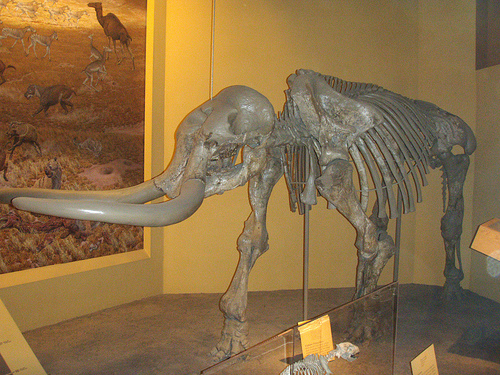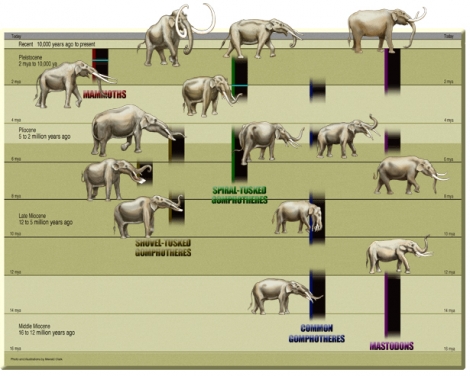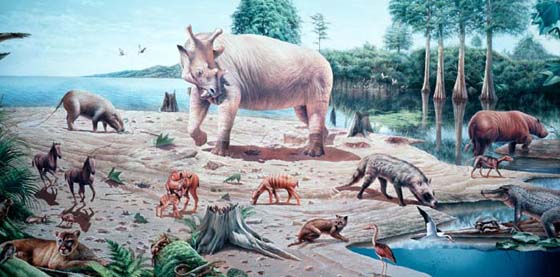Cenozoic Fossils of Nebraska
At the end of the Cretaceous, an asteroid impact led to the extinction of dinosaurs, ammonites and many other faunas. After the end-Cretaceous mass extinction, the numbers and diversity of mammals increased leading to the "Age of Mammals" during the Cenozoic. In the oceans large marine reptiles of the Mesozoic were replaced by sharks (as well as some species of whale) as top carnivores. In Nebraska during the Cenozoic, elephants, rhinoceros horses, large bison, and camels (as well as others) could be found roaming the landscape. Due to the excellent geological record in Nebraska, this page is mainly devoted to the elephant.
Elephants in Nebraska
At different times during the Cenozoic, many types of elephants roamed the Nebraska landscape. Four-tuskers, Stegomastodons, Mastodons, and Mammoths were some of the most common elephants in Nebraska during the Cenozoic. Information on these elephants is listed below.
Four-tuskers:
Four-tuskers migrated to North America from Asia and were present in Nebraska during the Middle and Late Miocene. Remains of four-tuskers are found in the Ogallala Group. They
are the oldest elephant known to exist in Nebraska, and were surrounded by savanna and grassland vegetation, which was present on the Miocene landscape in Nebraska. Many of the four-tuskers remains have been found in north-central Nebraska near the town of Valentine.
 |
One type of four-tusker, a shovel-tusker, named Amebelodontid. Photo from: http://tanystropheus.wordpress.com/2008/12/ |
Stegomastodon:
 |
A photo of Stegomastodon, (S.mirificus) from the Smithsonian Natural History Museum: |
Stegomastodon from Nebraska at the University of Nebraska State Museum. Photo by Zi Gui. |
Mastodons:
Mastodons were present in Nebraska from 2 million until about 10,000 years ago. The climate in Nebraska was much cooler and drier because of the ice age in the Northern Hemisphere, which started around 1.8 million years ago. Mastodons ate
shrubs and pine trees in a grassland-dominated ecosystem. Remains of Mastodons are found in the glacial
deposits in the eastern part of Nebraska.
 |
Drawing of a Mastodon from the Illinois State Geological Survey website: http://www.isgs.uiuc.edu/education/ice-age-res/mastodon.shtml |
| A photo of a Mastodon skeleton from Nebraska, in the University of Nebraska State Museum. Photo by Zi Gui. |
Mammoths:
Mammoths are the most commonly found elephant fossil in Nebraska. Mammoths were present in Nebraska from ~ 2 million until about 10,000 years ago. Various species of
mammoth crossed the Bering Strait land bridge about and spread
throughout most of North America. In 1967, the state of Nebraska designated the Mammoth as the official state fossil. The world's largest Mammoth skeleton was found in Lincoln
County, Nebraska; nicknamed "Archie." This extremelylarge Mammoth is on display in the University of
Nebraska State Museum.
 |
Drawing of a Mammoth from: |
Photo of "Archie" from the University of Nebraska State Museum. Photo by Zi Gui. |
A Timeline of Elephant Evolution in North America
 |
Figure showing the North American elephant evolution during the Cenozoic Era; image from: http://tanystropheus.wordpress.com/category/ proboscideans/ |
Other Cennozoic-age fossils from Nebraska can be seen on the University of Nebraska State Museum website:
http://www-museum.unl.edu/research/vertpaleo/necounties/index.html
Some Common Faunas during the Cenozoic Era
 |
 |
 |
 |
Eocene Mammal diversity increased greatly during the Eocene. Modern hoofed herbivores evolved along with ancestors of the elephant, called Moeritherium. The earliest bats and large whales appeared during this period. Giant 6-foot tall predatory birds, called Diatrymas were present during the Eocene and most likely fed on many species of smaller mammals.
|
Oligocene Mammal diversity reached a peak during the Oligocene, which included the largest terrestrialmammal group, known as Paraceratherium (a giant herbivore related to the rhinoceros). Primates, including monkeys, also began to diversify during the Oligocene.
|
Miocene Since grassland was the dominant vegetation, more species of grass-eating herbivores continued to evolved from more primitiveexamples earlier in the Cenozoic (i.e. horses, deer, camels, etc.). Also abundant were frogs, rats, mice, snakes, many species of birds, and carnivores such as wolf/dog-like mammals.
|
Pleistocene Mammoths and Mastodons dominated the landscape during the Pleistocene "ice ages." Humans arrived from Asia about 10,000 years ago, which coincides with the extinction of many of the megafauna like elephants, giant sloths, saber-tooth cats, etc.
|
Eocene image from: http://anthropology.si.edu/humanorigins/faq/gt/cenozoic/cenozoic.htm Oligocene image from: http://www.msnucleus.org/gordon/preview.htm Miocene image from: http://www.scienceart.com/image.asp?id=144&search=1 Pleistocene image from: http://www.environmentalgraffiti.com/ecology/home-erectus-crosses-open-ocean/10658
More information about Cenozoic fauna can be found at: http://www.cbs.dtu.dk/staff/dave/roanoke/bio101ch19_c.htm and http://anthropology.si.edu/humanorigins/faq/gt/cenozoic/cenozoic.htm |